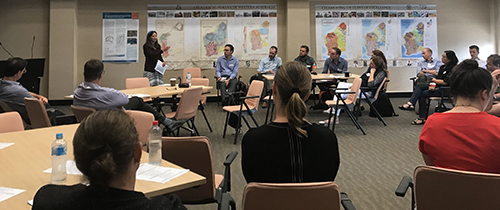National Drilling Initiative: reducing exploration risk.
Held in Perth on 22–23 February 2019, the start-up meeting for the first three-year phase of the MinEx CRC Program 3 drew participants from four state geological surveys, Geoscience Australia, CSIRO and multiple universities. (Photo 417746)
Research directions for the first three-year phase of the MinEx CRC Program 3 were developed at the recent start-up meeting. Participants came from the Geological Survey of South Australia (GSSA), three other state geological surveys, Geoscience Australia, CSIRO, and multiple universities including University of South Australia and University of Adelaide.
MinEx CRC aims to address the decline in mineral discovery rates in Australia. Programs 1 and 2 are focused on developing new technologies for drilling and real-time data collection. Methodologies will include improving ‘traditional’ drilling methods such as diamond and rotary, enhancing the capacity of the coiled tubing drill rig, downhole geochemical assay and automated 3D modelling. These technology streams are envisaged to be a platform for the success of future mineral exploration.
Coupled to these two technology development programs is Program 3, the ambitious National Drilling Initiative (NDI). This program is built around three themes of data accessibility and decision-making tools for drilling, understanding geological architecture and evolution, and mineral systems research. These broad themes are planned to be integrated to form powerful methodologies for reducing the risk of mineral exploration programs by combining fundamental geoscientific information and high-end data analytics. The NDI will also provide the platform for researchers in Programs 1 and 2 to field test their new technologies in a range of challenging geological environments across the Australian continent.
The locations of these NDI projects are planned to specifically address major gaps in our understanding of the Australian continent and also extend geological knowledge and mineral potential beneath cover successions from exposed terranes where exploration has traditionally focused. In this respect, the NDI is a contribution to the broader aims of the UNCOVER initiative.
GSSA is now in the process of deciding what regions of South Australia are the priority for our NDI drilling campaigns. Regions under consideration are the Curnamona Province, the Delamerian Orogen and the central Gawler Craton. We aim to deliver new geoscience knowledge and data for our stakeholders in these regions, with the drilling component of the NDI being envisaged as a final outcome of a holistic geoscientific workflow that encompasses:
- understanding the cover successions and regolith geology
- mapping the lithospheric architecture through electrical and seismic methods coupled with isotopic controls from magmatic systems
- progressing knowledge of the basement geology and architecture through regional mapping and geophysical interpretations.
Importantly, as the NDI is national in scope and is being approached in a truly collaborative spirit by the participant geological surveys and research partners, the outcomes of this project have the potential to result in a much larger impact than previous drilling campaigns undertaken at the local or state scale. Watch this space.
– Anthony Reid, Adrian Fabris and Caroline Tiddy, April 2019



